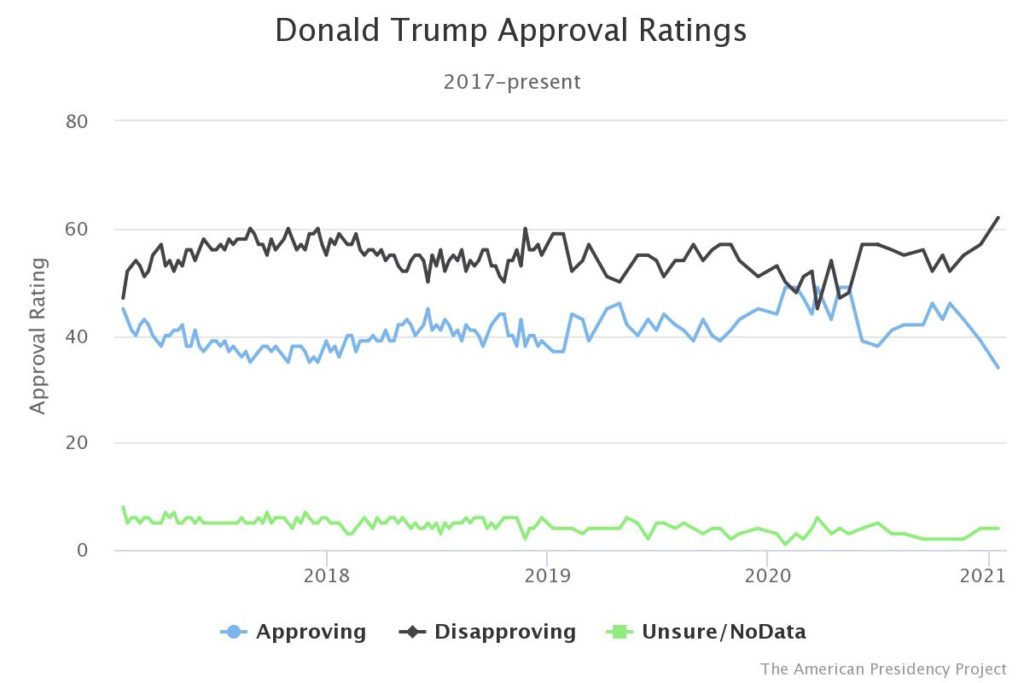featured insight
featured insight

The Honeymooners
A Historical Look at Presidential Approval Ratings
A lot of plans have been forced to change over the past year. Family holidays were spent on Zoom, work trips were postponed, weddings were downsized, and even honeymoons were cancelled. One such lovestruck couple anxiously eyeing their precarious honeymoon plans are Joe Biden and his Presidential approval rating.
Presidents typically enjoy elevated job approval ratings in their first months in office—a honeymoon period—before political gravity takes hold, disappointment sets in, and job approval ratings fall back to earth. Polling conducted by Gallup since World War II has shown that Americans have historically been willing to give their new Commanders-in-Chief the benefit of the doubt at first.
For instance, President Obama entered office with two-thirds of Americans approving of his job performance. By the end of his first August in office, his approval had dropped to 50%. His job approval rating improved during the 2012 and 2016 campaigns, but it never matched the highs of the first few months.

President George W. Bush’s approval rating was in the 60s for his first few months before falling to 51% before the September 11th attacks. His ratings got a major bounce in the aftermath of the attacks and smaller bounces during Operation Iraqi Freedom and again when Saddam Hussein was captured; but once those bounces subsided, his approval rating never again hit those early highs.

One month into the Clinton Administration, President Clinton hit an approval rating of 59%, 16 percentage points higher than the 43% of the vote he won in 1992. But that 59% was the high-water mark of his first term (except for the week after the 1996 Democratic National Convention), as scandals hit early and his approval fell.

Likewise, the first President Bush started his term with a high approval rating. But extraordinarily, his approval rating actually went up, aided by the popularity of the Gulf War. It wasn’t until December 1991—nearly three years into his term—that his approval rating dropped below the 51% it started at.

President Ronald Reagan’s honeymoon period is unique: His job approval shot up after he survived an assassination attempt early in his first term. But the bounce faded fairly quickly; his approval rating dipped below 50% before his first year in office was over. His job approval was eventually able to recover, and he started his second term with an approval rating in the 60s before it fell again after the revelation of Iran–Contra.

Jimmy Carter’s approval rating started out very high. It hit 75% before falling for the remainder of his Presidency. He trudged through the bulk of the 1980 campaign with an approval rating in the 30s before losing his reelection bid by 10 points.

Gerald Ford started out with a 71% approval rating in August 1974, but after his pardon of Nixon, it fell by more than 20 points and never recovered.

Richard Nixon was able to make the magic last longer than most. His approval rating stayed above 60% for much of his first year in office before slowly fading. But despite a tick up during the campaign of 1972, he was never able to revive those early numbers (except for a brief bounce in January 1973 after announcing the U.S. would suspend offensive action in North Vietnam). He resigned with an approval rating of 24%.

Lyndon Johnson stepped into the presidency after the assassination of his popular predecessor. Starting above 75%, his time in office was characterized by a long and steady decline in his approval until he decided not to run for reelection.

John Kennedy’s approval rating stayed near 75% for his first 16 months in office. He remained quite popular throughout his Presidency, but, except for a bounce after the Cuban Missile Crisis, his approval rating never again matched those early highs.

President Eisenhower’s honeymoon period lasted his entire first term and propelled him to a landslide 15-point reelection in 1956 in which he won all but seven states. But the magic was gone by his second term.

Harry Truman came into office with an 87% approval rating, a mark only surpassed twice—once by President George H. W. Bush during the First Gulf War and again by President George W. Bush after the 9/11 attacks. But Truman’s approval quickly fell and never recovered. It bounced around quite a bit for the rest of his time in office, hitting a low of 22% in February 1952. This is the lowest Presidential approval rating Gallup ever measured.

But, as interesting as I may find all this history (and I assume you do, too, if you’re still reading at this point), it’s hard to believe that a bygone America where 87% of us agree on anything is particularly relevant today. President Trump did not experience a honeymoon period, and while you might think his Presidency was chaotic, his approval ratings will go down in history as the most stable ever measured.

President Biden ran on a promise to break the divisive stalemate gripping our national politics. The question for the incoming Administration is whether Americans will be willing to give him the benefit of the doubt other Presidents throughout history have been afforded, or whether the give-no-quarter divisiveness that characterized the Trump era will continue for his successor.
What do you want to know? We can help. Get in touch or subscribe to our newsletter.
All data and visuals come from The American Presidency Project, a website co-directed by John Woolley, Professor of Political Science at UC Santa Barbara, and Gerhard Peters, Professor of Political Science at Citrus College. Find this data and many other presidential documents at https://www.presidency.ucsb.edu/statistics/data/presidential-job-approval

